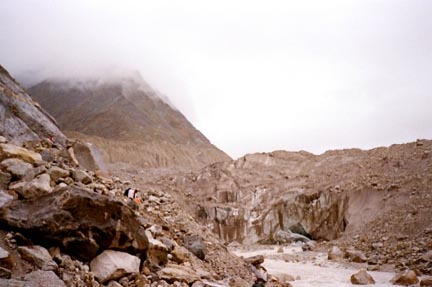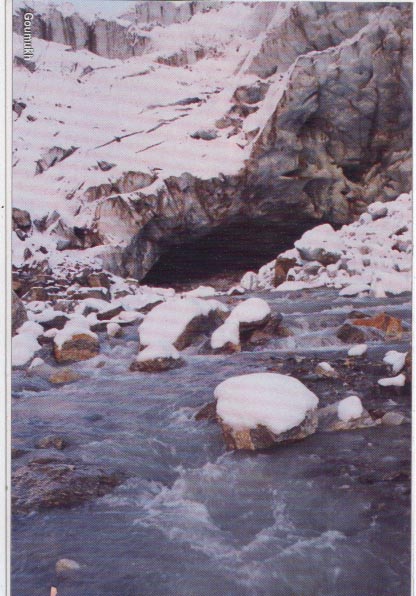On a trail of the Ganga -
PART 1II
-Saraswati Kavula
 I moved on from Chirbasa towards Bhojbasa which was another 5 kilometres away. On the way, there were numerous landslides. We had to look out before
we crossed the line of the land slides. There was a constant danger of the rocks tumbling down. Anyway, me and a couple of men from Delhi who too were on the mules, moved on cautiously, each animal was led by a driver –local youth who get paid, Rs.50 for taking
us up and then back a total of 36 kilometres, walking and controlling the animal all the way, though the actual amount paid to the owner of the animal was 825. Out of which, Rs.250 was paid to the local governing body and 25 rupees as entry fee to the national
park and fifty rupees for the boy’s food. So, out of five hundred rupees, what the boy gets for his work was only Rs.50. I asked him “how much does he walk in a day”, “I can walk up to 80 kms.” My mule driver told me that the landslides have been increasing
over the years.
I moved on from Chirbasa towards Bhojbasa which was another 5 kilometres away. On the way, there were numerous landslides. We had to look out before
we crossed the line of the land slides. There was a constant danger of the rocks tumbling down. Anyway, me and a couple of men from Delhi who too were on the mules, moved on cautiously, each animal was led by a driver –local youth who get paid, Rs.50 for taking
us up and then back a total of 36 kilometres, walking and controlling the animal all the way, though the actual amount paid to the owner of the animal was 825. Out of which, Rs.250 was paid to the local governing body and 25 rupees as entry fee to the national
park and fifty rupees for the boy’s food. So, out of five hundred rupees, what the boy gets for his work was only Rs.50. I asked him “how much does he walk in a day”, “I can walk up to 80 kms.” My mule driver told me that the landslides have been increasing
over the years.
With some difficulty we reached Bhojbasa, which had numerous Dhabas, and down in the valley, there were a couple of hotels too, one was an ashram with
basic dormitory facilities and another was the Garhwal Mandal Vikas Nigam’s Tourist Bunglow. From here one could see the surrounding area all the way up to the Gomukh area. My driver pointed out, “Just beyond that mountain is Gomukh” I looked out, did not
find any traces of a glacier. It was another four kilometres from Bhojbasa. After a short tea break at one of the dhabas, we set out once again. We reached the next stop – another Dhaba close to Gomukh, my driver told me to get down and said, “You have to
walk up about some distance to reach the Glacier”. I looked around; the entire place was like a dry, cold, desert, just muddy mountains, and rocks, no signs of any snow. The Ganges was flowing on one side. We found people returning from the other side. With
the difficulty of a still back, I managed to climb up and down the slippery rocks, (since it was raining) and one kept walking with no sign of the glacier. One man was returning from the other side, I asked him, “How far is the glacier?” He replied, “Look
over there, another one kilometre, you find it.” I looked in the direction where he pointed; I could only see a cave in a far distance with some ice in it. “That one?” “Yes there, you can see some people taking a bath in the river near the cave? The same place?”
he replied. ‘Is that all there is?” “Yes”. I must say, I was terribly disappointed. 
In fact, I had a better view of the mountain snows when I had been on a trek to the Sarakhund Pass in Himachal. That was ten years ago, one cannot say
what is the state of affairs in that place now. So, I decided to return and made my way back on the mule, after a short break for lunch at the Dhaba near Gomukh. At Chirbasa once again we stopped for some tea. My Mule mates from Delhi too felt that they were
disappointed with the Glacier. They did go up to the cave and took a dip in the freezing cold Ganga’s water, but were disappointed with the view of a barren deserted area.
Over tea, we discussed my conversation with the trekkers, to which they commented, “Well, it is thanks to these nature loving, adventure seekers, that Everest has become a trash can today”.
All the way, I found lots of Hindu Sadhus walking up and down the path to the Glacier. At least, they were being more eco-friendly – most of them
carried water in their brass pots, and carried their minimum rations as well. I was surprised, most of them walked bare foot and had only their lungi and kurta covering their bodies in that freezing cold. I heard that many of them stay back in the numerous
caves that dot the mountains and may walk up to Tapovan and Nandanvan in the same way. Their religious beliefs apart, at least they were not demanding on the local resources like the touring pilgrims and trekkers.
I was back at Gangotri the same evening. The next day morning, I was going through the market, and stopped at a place to make a long distance call. On
the table there were some photographs of people crossing the glacier near Tapovan and the Gomukh Glacier itself in all its splendour. I told the man of my experience, and said that I was disappointed. “Yes, they must ban trekking in this area, in fact; no
one should be allowed to go beyond Gangotri. People are constantly walking on the glacier and it is affecting it very much”. I asked him if he had been there, “yes, I had gone on a couple of mountaineering trips to Tapovan and beyond to Nandanvan, as a guide
with mountaineering groups that arrive here. The Nehru Institute of Mountaineering organise many training camps in this area, every summer”. I was a bit taken aback, I asked him, “well, you had been on those glaciers yourself, but now you say that others should
be stopped from entering the area!’ He shifted a bit uncomfortably, “well, yes, but now, the glacier is getting destroyed, so it must be stopped!’
 I asked him if I could borrow the photographs, he said, ‘you can, if you want more, you can buy them from the shop opposite, where we have
kept these pictures for sale, most of them have been taken by me’. I thanked him and went on to purchase a couple of photos of the Gomukh and the trekking parties. From the photo shop I walked up to the Gauri Kund, a place where the Ganga falls into a pool
with great force. I had to cross an ashram to go there. One of the sadhus from the Ashram, Gyanand maharaj, told me to go across and watch the waterfalls from their compound wall. As I was peeping over the wall and listening to the roar of the water, I found
trash lining the walls of the valley just above the water. Gyanji was standing next to me speaking to some visitor, “This time the sound of the water is very less. There was not much snow this year. But normally, when you sit inside the ashram and concentrate
on the sound of the water, you can easily slip into a state of meditation and bliss” I remarked to him, “I am surprised that while people come here all the way to pray to Ganga, they don’t think twice before dumping trash that pollutes the river”. Gyanji replied,
“Well, that is what Sanatana Dharma teaches, to live in harmony with nature, there is nothing more to it, unfortunately people are stuck in outwardly rituals’.
I asked him if I could borrow the photographs, he said, ‘you can, if you want more, you can buy them from the shop opposite, where we have
kept these pictures for sale, most of them have been taken by me’. I thanked him and went on to purchase a couple of photos of the Gomukh and the trekking parties. From the photo shop I walked up to the Gauri Kund, a place where the Ganga falls into a pool
with great force. I had to cross an ashram to go there. One of the sadhus from the Ashram, Gyanand maharaj, told me to go across and watch the waterfalls from their compound wall. As I was peeping over the wall and listening to the roar of the water, I found
trash lining the walls of the valley just above the water. Gyanji was standing next to me speaking to some visitor, “This time the sound of the water is very less. There was not much snow this year. But normally, when you sit inside the ashram and concentrate
on the sound of the water, you can easily slip into a state of meditation and bliss” I remarked to him, “I am surprised that while people come here all the way to pray to Ganga, they don’t think twice before dumping trash that pollutes the river”. Gyanji replied,
“Well, that is what Sanatana Dharma teaches, to live in harmony with nature, there is nothing more to it, unfortunately people are stuck in outwardly rituals’.
( Photographs: 1.Way to Bhojwasa and 2.Gomukh as it is today by Saraswati Kavula.
3. Gomukh with snow from postcard)
-To be continued